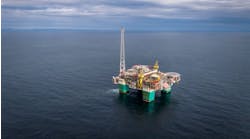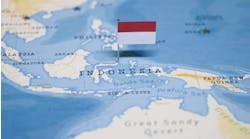- The Captain newbuild FPSO at Astano's yard in Ferrol, northern Spain prior to launching in 1996. [55,312 bytes]
- Erection and fit-out of the turret for Texaco's Captain FPSO. [15,393 bytes]
- Process module outfitting on the Petrojarl Foinaven. [42,493 bytes]
- Uisge Gorm under conversion for Amerada Hess at the C diz yard of Astilleros Españoles. [14,434 bytes]
- The Captain FPSO during sailaway from the Ferrol river last December. [14,791 bytes]
But the oil industry generally was slow to follow. Apart from a few BHP-owned installations in the Timor Sea, floaters elsewhere over the next 15 years were limited largely to production semis, which lacked onboard storage, plus the occasional, but costly, TLP.
A sea-change occurred in the early 1990s, led by Europe. Operators accepted that the days of big new discoveries in the North Sea were over, and were instead seeking profitable solutions to their old, dormant marginal discoveries. At the same time, attention was focussing on achieving production from deeper waters outside the North Sea, such as Mid-Norway and the Americas.
The impetus for what is now a wave of fast-track FPSO-based developments came from a few far-sighted designers in Norway and an adventurous shipyard group in Spain. Astilleros Españoles led the way for FPSO newbuilds and conversions in Europe, and it continues to lead the market today in securing new types of offshore business.
Astilleros identified the coming opportunities in the late 1980s. With its traditional market, shipbuilding, in decline at the time, Astilleros decided to invest heavily in a facility to build the new types of floating units, backed by funds from the European Union. This facility, named Astano, was on the site of a shipyard in Ferrol, Galicia.
Gryphon A
Its first FPSO construction project was Kerr-McGee UK's Gryphon, in 1992. Kerr-McGee considered several development options, including a concrete platform and a converted semi, but was persuaded that in terms of time and economics, a ready-made floater was the way forward. The project attracted universal interest, as this was the first solution of its kind adopted for a short-term North Sea field.For project manager Smedvig and Astano, this was also a gamble, particularly during the newbuild's speculative status early on before the contract with Kerr-McGee was wrapped up. Gryphon A was a Tentech 850C, double longitudinal, transverse bulkhead, dual-hulled design. For Astano, construction proved to be a complicated and difficult learning curve according to Juan Carlos-Pérez, Astilleros' executive vice-president, Commercial & Marketing, because of North Sea offshore oil production standards and requirements (NPD, NMD and others).
Halfway through the Gryphon project, Astano was also contracted by Chevron to build the North Sea's first floating storage unit for the Alba North platform. With Chevron's approval, Astano then became the first yard to deal with Britain's Health & Safety Executive concerning safety guidelines for a floater. Chevron eventually submitted the FSU's Safety Case to the HSE, but all hazard and HAZOP studies had been managed by Astano - the first such studies for a newbuild, fit-for-purpose floater following Lord Cullen's Piper Alpha report.
Other North Sea oil companies were also watching in this case to see whether the right amount of safety paperwork was being generated, but the end result was well received by the HSE. "Maybe a bit less paperwork is needed now," Pérez suggests.
More importantly, he says, the industry was "astonished" by the performance of both the FSU and the Gryphon A when they started operating in 1993. Kerr-McGee, for instance, reported greater than 97% availability from the Gryphon FPSO during its first year's service.
This 550,000 bbl storage vessel is currently producing 40,000b/d of oil, but there is space onboard to upgrade processing capability to 90,000b/d. The turret can accommodate up to 15 risers, and the riser tubes, being 1.1 meter in diameter, also allow more than one riser to be pulled within the tube. Kerr-McGee is thought to have untapped pockets of oil close to the main Gryphon Field, and there have been discussions with other operators about processing nearby third party oil finds through the Gryphon A.
Another attraction of the vessel was that it could be moved for service elsewhere, following Gryphon Field abandonment (field life was anticipated at six to ten years). "The residual value had a very big impact on the client," says Pérez.
Next step in FPSO thinking in the North Sea was whether a conversion could be attempted, or whether a newbuild was mandatory. Amerada Hess opted for a conversion for its Fife development, purchasing the tanker Uisge Gorm for this purpose. The work was placed with Astilleros' C diz yard which was becoming dedicated to offshore conversions under the group's improvement strategy.
By 1993-94, yards across Britain were following Astilleros' lead, equipping themselves either for FPSO re-fits or topsides installation, as marginal field developments began rapidly to dominate the UKCS. In Norway, meanwhile, the oil companies were exploiting their massive oilfields, such as Norne and Varg, through newbuild vessels commissioned from the Far East.
Astano, however, set another first by installing and integrating process plant on FPSOs built at its own premises. Opportunities arose through simultaneous contracts for BP's Petrojarl IV conversion for the Foinaven project (covered elsewhere in this report) and Texaco's Captain FPSO newbuilding. These jobs were executed during 1995-96.
Pérez describes Captain as a "pioneering" contract between Texaco and the various alliance contractors. The technology was unusual, involving widespread use of horizontal wells and downhole semisubmersible pumps to maximize recovery of the field's heavy, viscous oil. Also, the FPSO (connected by pipeline to a wellhead protector platform) was to house not only process plant, but also lube oil, gas storage and power generation equipment for the entire development. "Chevron asked us if this was feasible," says Pérez, "and we said `yes'."
The alliance terms were also pioneering. To ensure progress of the fast-track, two-year development towards the target date of first oil in late 1996, different aspects of the hardware construction were to be performed strictly in tandem. This way, all parts of the team would know exactly what the others were working on, rather than viewing each other as a standalone operation.
In the event, first oil was delayed until February this year, owing to last-minute modifications to the FPSO and late riser hook-up operations. But the vessel has now begun generating regular cargoes of crude offloaded to a special-purpose tanker - also built by Astilleros, in Bilbao.
Captain's FPSO - a Tentech 700 design - is moored by an eight-point system anchored in 350ft of water in the Outer Moray Firth. It can handle up to 140,000b/d of produced water and store 550,000 bbl of oil, with a crude processing limit currently of 60,000b/d. This will likely be upgraded to 100,000b/d for the next phase of the development, which aims to exploit an area of the reservoir known as Area B. A second WP platform could then be installed, tied back to the FPSO.
Brazil
Astilleros' next foray into floating production was to convert a tanker and a semisubmersible for the latest phase of Petrobras' Marlim Field development, where production will be performed in 1,000 meters of water. These jobs have just been concluded at the C diz branch. Astilleros hopes to gain several more contracts for Brazil now that its ways of working are known in this market.It will not be easy, says Pérez, as contracts in this sector are traditionally issued on the basis of an auction, where the lowest prices win. This philosophy militates in favor of continued conversions of existing tankers. However, he adds, Petrobras is so encouraged by the emergence of technology for all types of units that it may in future consider TLPs and SPARs.
Astano could build both these types of units, he claims. "We have undertaken construction plans which would demonstrate to the industry that we could be more competitive in the construction of TLP hulls than some established players." Deepwater developments under review include Exxon's Micky and Diana in the Gulf of Mexico. In TLP construction terms Astano is contemplating 90 manhours/ton for the nodes, 60 manhours/t for the columns and maybe 40 manhours/t for the pontoons.
Astano's yard has launching ways, though not a drydock, to accommodate newbuilds up to 400,000dwt, with lifting capacity via a gantry crane of 800t. The geometry of the launching ways might prohibit building a super-giant TLP, but 80% of the construction could be handled without problems, according to Pérez. If not, he says, Astilleros would consider shifting construction to its larger yard in Puerto Real, Andalucia where no new investment would be needed. Mini-TLPs for the West African market could be managed comfortably at Astano.
FPSOs serving future West African deepwater developments are more likely to be conversions than newbuilds, Pérez believes, as the milder sea conditions impose lesser structural strains than in the North Sea. This could also allow turrets to be external, or even spread moored, as in the case of the Independence FPSO delivered recently by Astilleros' C diz yard for Conoco's Ukpokiti project off Nigeria.
Off Newfoundland, by contrast, new generations of FPSOs will be needed with ice reinforcement and speed release systems on the turret to escape impact from rogue icebergs. Astilleros is watching this market closely - with local work content seemingly mandatory in this market, turret and process module installation could be devolved to a Canadian yard.
As for the North Sea, Pérez sees competition for new FPSO work getting tighter, with so many European yards now geared for this market. With all-round project capability becoming a pre-requisite, they will have to form joint ventures with multidisciplinary contractors to make bid lists, as Astano has done recently with ABB to try to enter the Norwegian market.
Despite the widespread facility investments, Pérez believes that Astilleros and Astano still hold a competitive edge in FPSOs. "We have the pioneering know-how, which means the others all have to pass through a learning curve to catch us up." He points out that Astilleros is the only group to have installed all types of turret and mooring technology, including Sofec's for the Barracuda Pilot System FPSO in the Campos Basin, which accommodates 34 risers in 834 meters water depth.
Meanwhile, Astilleros' internal improvement program continues. One area targeted is North Sea health and safety. Another is electrical instrumentation, fire and gas automation on FPSO - these, the group has discovered, take up three times the length of cables and four times the number of I/O units to be monitored compared with conventional ships.
"The know-how to accomplish workability of these systems will continue to be amassed," says Pérez. "We will have to continue monitoring and increasing efficiency and developing procedures to aid successful completion within the scheduled contract time."
But the oil industry in turn must improve its assessment of development needs. There is still general underestimation of the requirements for an FPSO destined for many years' service. Easy inspection access to all parts of the vessel is critical for long-term performance to be monitored successfully. If that access is not planned from the outset, it will cost enormous amounts to incorporate at a later date. "That's why newbuilds are often more competitive than conversions," Pérez says.
Drillships are now being built to drill in 10,000ft of water, with dual derricks. Once performance is proven, FPSOs will follow in these depths, he adds, and in parallel, solutions will emerge for making full use of associated gas from oil instead of the current practice of compression or burning. Astilleros Españoles is itself starting to address these problems.
Copyright 1997 Oil & Gas Journal. All Rights Reserved.


